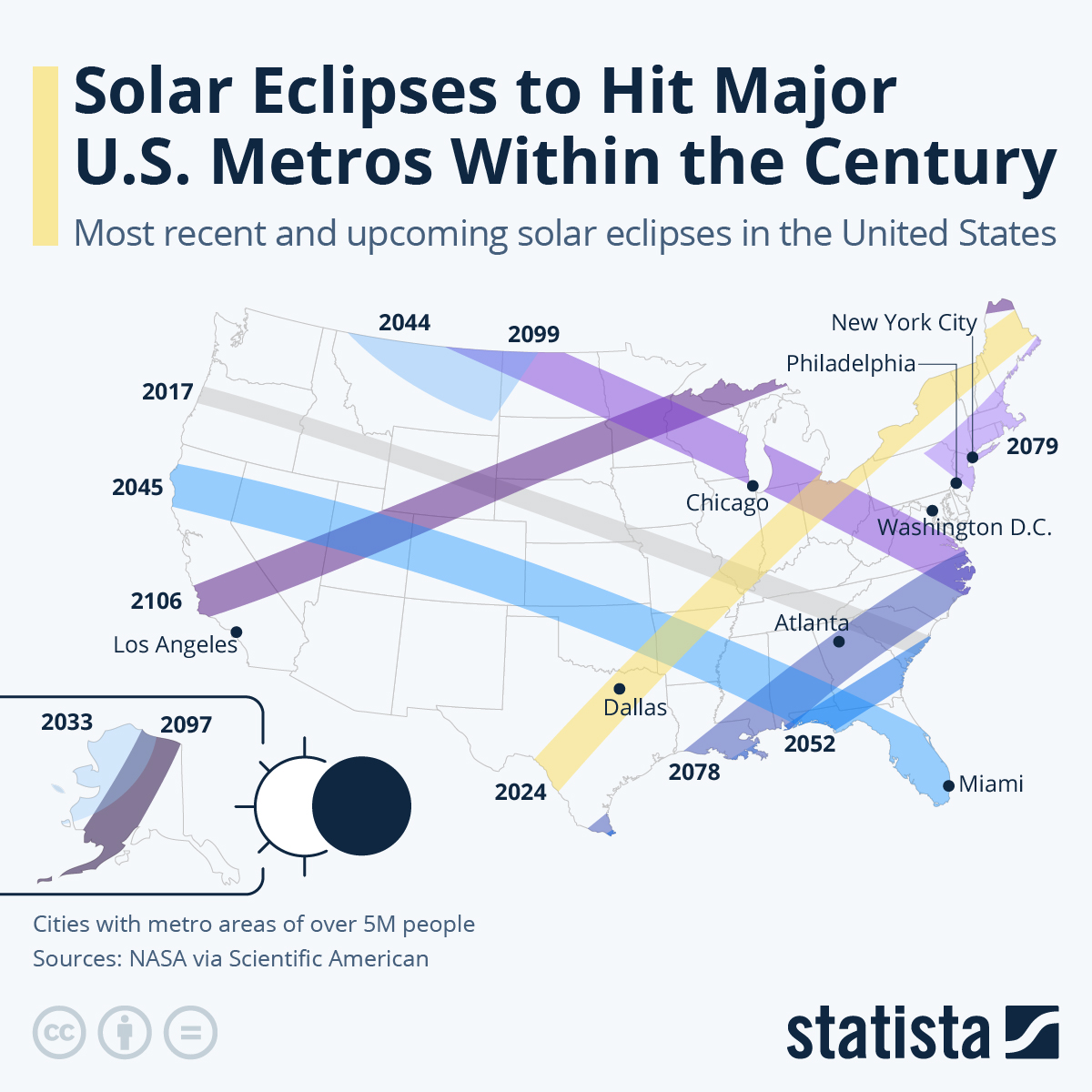- Topics›
- Domestic tourism in the U.S.›
Solar Eclipse
A solar eclipse is happening in the United States on Monday. The moon will fully obscure the sun in a band that crosses Mexico, 15 states and a small part of Eastern Canada including Montreal and Toronto. The biggest metro that falls within the area for this solar eclipse is Dallas, where the event will begin at 12.23 p.m. but might be hampered by bad weather forecast for the day. The eclipse area will then move across Arkansas, Missouri, Illinois, Indiana, Ohio, upstate New York and parts of New England. In 2017, a solar eclipse had been visible in a small band between Oregon and South Carolina, passing over Kansas City, St. Louis, Nashville and Charleston.
According to reports, accommodation across the band has been booked solid for the upcoming Monday as many people are willing to travel to experience the event that for many happens only once in a lifetime. Within this century, however, full solar eclipses will pass over more major U.S. metros. After solar eclipses that will be visible in Northern Alaska in 2033 as well as Montana and North Dakota in 2044, the next major eclipse in the United States is coming up in 2045, hitting the Miami metro and other major Florida cities as well as Northern California, most of Colorado, Oklahoma City and once again, Arkansas.
In 2078 and 2079, dual eclipses will first hit New Orleans and Atlanta (while missing Houston by several hours) and then New York, Boston and Philadelphia. Chicago will have to wait until 2099 for an eclipse that also hits Minneapolis and Detroit and passes by very close to the nation's capital, Washington D.C. This makes the current century much more active for solar eclipses in the United States than the past one, which saw most events only skirt the lower 48. Eclipses passed through the Northwest in 1945 and 1979, the Great Lakes in 1925 and 1954, New York in 1925 and New England on three more occasion. In 1970, Northern Florida and the Atlantic Coast of Georgia and the Carolinas experienced another solar eclipse.
Finally, beyond this century, in 2106, a solar eclipse is passing near Los Angeles, only closely missing Santa Barbara while also passing by Salt Lake City and, once more, Minneapolis. This means that in the next roughly 100 years, the only U.S. metros with more than 5 million inhabitants as of 2023 that will not be in the path of a full solar eclipse or at least close to one will be Phoenix, Ariz.

Katharina Buchholz
Data Journalist
katharina.buchholz@statista.com

Description
This chart shows the most recent and upcoming total solar eclipses in the United States.
Report
Related Infographics
FAQ
The Statista "Chart of the Day", made available under the Creative Commons License CC BY-ND 3.0, may be used and displayed without charge by all commercial and non-commercial websites. Use is, however, only permitted with proper attribution to Statista. When publishing one of these graphics, please include a backlink to the respective infographic URL. More Information
The Statista "Chart of the Day" currently focuses on two sectors: "Media and Technology", updated daily and featuring the latest statistics from the media, internet, telecommunications and consumer electronics industries; and "Economy and Society", which current data from the United States and around the world relating to economic and political issues as well as sports and entertainment.
For individual content and infographics in your Corporate Design, please visit our agency website www.statista.design
Any more questions?
Get in touch with us quickly and easily.
We are happy tohelp!
Do you still have questions?
Feel free to contact us anytime using our contact form or visit our FAQ page.
Your contact to the Infographics Newsroom

Felix Richter
Data Journalist
felix.richter@statista.com +49 (40) 284 841 557

Statista Content & Design
Need infographics, animated videos, presentations, data research or social media charts?
The Statista Infographic Newsletter
Receive a new up-to-date issue every day for free

- Our infographics team prepares current information in a clear and understandable format
- Relevant facts covering media, economy, e-commerce, and FMCG topics
- Use our newsletter overview to manage the topics that you have subscribed to
